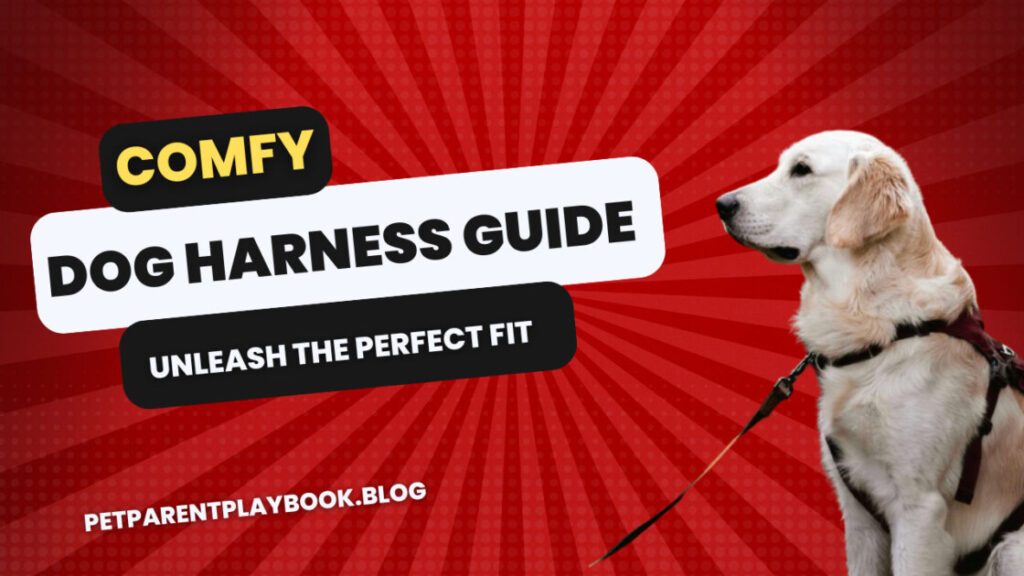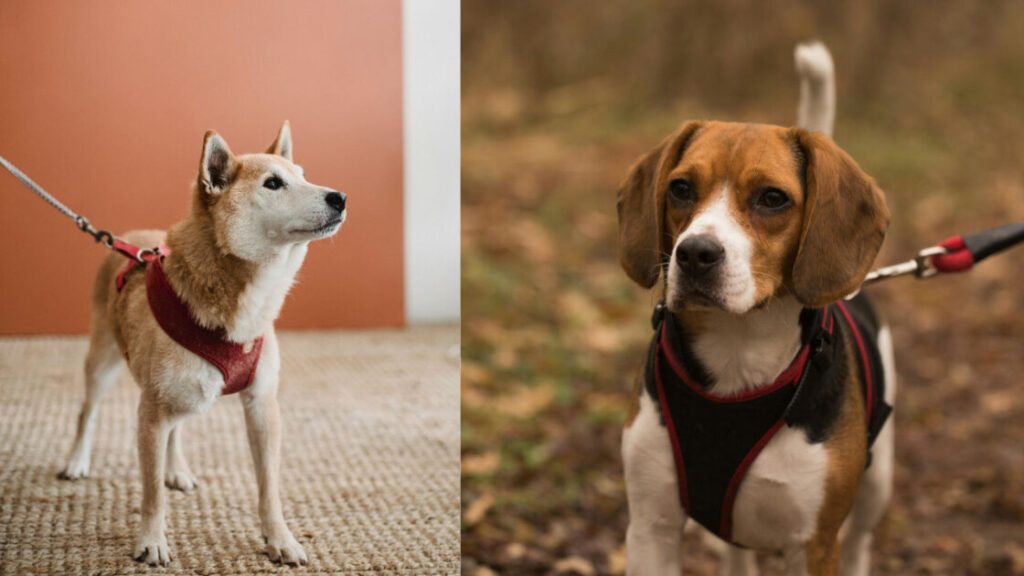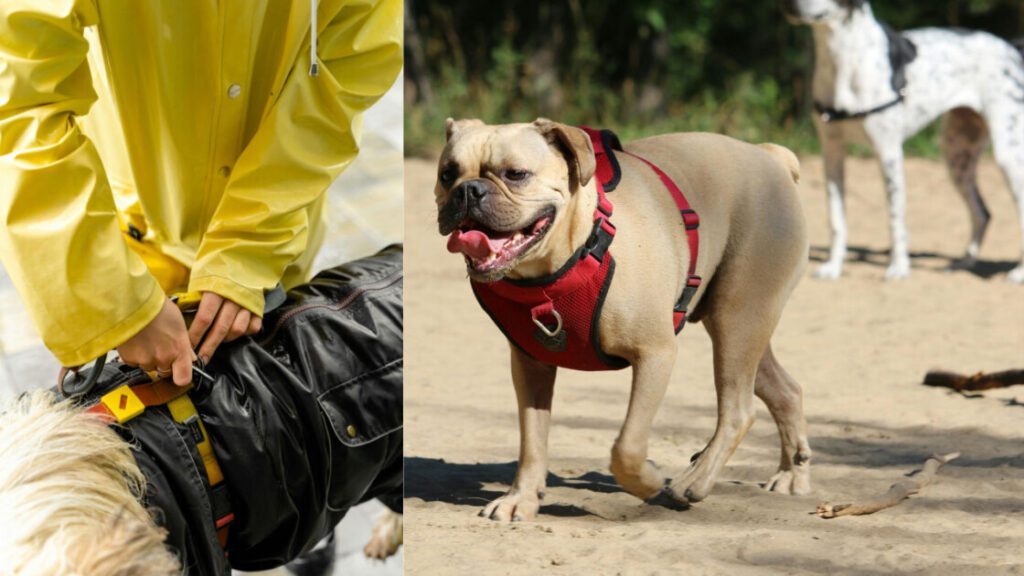Every dog owner cherishes the opportunity to bond with their furry friend during walks. But sometimes, those walks can become a frustrating tug-of-war battle. Enter the dog harness, a game-changer that offers comfort, control, and safety for both you and your pup.

This comprehensive guide explores the exciting world of dog harnesses, from the basic standard harness to the specialized tactical dog harness and the essential no-pull harness. We’ll also delve into the needs of small dog harnesses and explore the trusted brand of Kong dog harnesses. So, grab your leash, buckle up, and let’s unleash the power of harnesses!
Why Harnesses Rule (and Collars Don’t Always Drool)
We’ve all been there. You clip the leash onto your dog’s collar, excited for a walk, and suddenly, they turn into a Houdini, slipping and squirming. Collars, while convenient for identification tags, can be uncomfortable and even dangerous for some dogs, especially those with neck or breathing problems.
Dog harnesses offer a much more secure and comfortable alternative. They distribute pressure evenly across your dog’s chest and back, reducing strain on their neck and trachea. This translates to happier walks for both of you – no more choking or gagging for your pup, and no more feeling like you’re being dragged down the street!
But wait, there’s more! Harnesses come in a variety of styles, each designed with a specific purpose in mind. Let’s explore this exciting world of doggy attire!
Harness Havens: A Deep Dive into Different Types
- Standard Dog Harness: This is your classic, everyday walking companion. It typically features a chest plate and a back strap that connects to a leash attachment point. The standard harness is perfect for casual walks, offering comfort, control, and even weight distribution. When choosing a standard harness, ensure a snug but comfortable fit. You should be able to slip two fingers between the harness and your dog’s body.
- Tactical Dog Harness: Calling all adventurous dog owners and service dog handlers! The tactical harness is built for durability and functionality. Think of multiple attachment points for leashes, harnesses, and gear, alongside MOLLE webbing for carrying essentials like water bottles or waste bags. The reinforced stitching and rugged construction make this harness ideal for working dogs, service dogs, or those who enjoy exploring the great outdoors with their canine companions.
- Small Dog Harness: Our tiny terrorizers deserve comfort and safety too! Collars can be especially problematic for small dogs, putting undue pressure on their delicate necks. Small dog harnesses are specifically designed for pint-sized pups, often featuring a step-in design for easy on-and-off access. Look for soft padding, adjustable straps, and a secure fit that won’t restrict your dog’s movement.
- Dog Harness No Pull: Ah, the age-old problem – the leash becomes a tug-of-war rope! The no-pull harness uses clever design elements to discourage this behaviour. Many no-pull harnesses have a front-clip attachment point that gently redirects your dog when they pull, making walks a more enjoyable experience for everyone. Remember, no-pull harnesses are most effective when used in conjunction with positive reinforcement training.
- Kong Dog Harness: When it comes to dog products, Kong is a name synonymous with quality and trust. Kong dog harnesses are known for their durability, adjustability, and comfort-focused design. They come in various sizes and styles, catering to all breeds and activity levels. When choosing a kink harness, consider your dog’s size, needs, and the type of activities you’ll be doing together.
- Service Dog Harness: Service dogs are incredible animals who work tirelessly to assist people with disabilities. Their harnesses are not just fashion statements; they serve a vital purpose. Service dog vests typically display identifying patches or specific colours to signal their working status. Remember: If you encounter a service dog in public, always respect their space and avoid engaging with them unless their handler gives you the go-ahead.
Finding the Perfect Fit: Harness Harmony for Your Pup
Now that you’re familiar with the different harness types, let’s ensure you choose the right one for your furry friend. Here are some key factors to consider:

Choosing the Right Harness Based on Your Dog’s Needs
- Your Dog’s Needs: This is the most crucial factor. Consider your dog’s breed, size, activity level, and any specific needs they might have. For example, a small dog with breathing problems might benefit from a lightweight harness with a breathable mesh lining. Active dogs might require a more robust harness with secure buckles and attachment points.
- Measuring Your Dog: A good fit is essential for comfort and safety. To measure your dog for a harness, you’ll need a soft measuring tape. There are typically two key measurements to take:
- Chest Girth: Wrap the tape around the broadest part of your dog’s chest, just behind their front legs. Leave enough space to slip two fingers between the tape and your dog’s body.
- Neck Size: Measure around the base of your dog’s neck, where their collar would typically sit. This measurement is less crucial for most harnesses, but some might require it for proper fit.
Material and Comfort
- Material and Comfort: Your dog’s harness should be made from comfortable, breathable materials like padded mesh or fleece. Avoid stiff or rough materials that could irritate their skin.
Adjustability
- Adjustability: A harness with adjustable straps allows for a customized fit. This is especially important for puppies who are still growing.
Safety First: Tips for Using Your Dog Harness Responsibly
Harnesses are fantastic tools for safe and enjoyable walks but remember, safety is always paramount. Here are some tips to keep in mind:

Regular Harness Checks
- Regular Harness Checks: Just like any other pet gear, it’s important to regularly inspect your dog’s harness for wear and tear. Worn-out straps, loose buckles, or frayed edges could pose a safety risk. If you notice any damage, replace the harness immediately.
Matching Harness to Activity
- Matching Harness to Activity: Choose the appropriate harness for the intended activity. A standard harness might be perfect for a casual walk, while a tactical harness would be better suited for working dogs or adventurous outings.
Never Leave a Dog Unattended with a Harness
- Never Leave a Dog Unattended with a Harness: Harnesses can sometimes get caught on furniture or other objects, posing a strangulation risk. Always supervise your dog when they’re wearing a harness and never leave them unattended, especially when crated or confined.
Also Read –
- Is Shih Tzu hypoallergenic? Unmasking the Allergy Truth!
- The Domestic Short Hair: Unveiling the Allure of Your Feline Next Door
- The Borzoi: Unveiling the Majesty and Mystery of the Russian Wolfhound
- Snuggle Up and Save: The Ultimate Guide to Dog Beds on Sale (Especially for Large Breeds!)
- The Royal Treatment: A Guide to Royal Canin Dog Food (Wet, Dry & More!)
Unleashing the Joy: Final Thoughts on Harness Happiness
Dog harnesses are a win-win for both you and your furry friend. They offer comfort, control, safety, and even style! By choosing the right harness and following these simple tips, you can transform your walks into bonding experiences filled with joy and exploration. Remember, a happy dog makes a happy pet parent, and with the power of harnesses, those happy walks are just a leash clip away!
Do you have a favourite type of dog harness? Share your experiences and recommendations in the comments below! We’d love to hear from you and continue the conversation about keeping our furry companions safe and happy during their walks.
Happy Trails!
Here are some additional and helpful links:
- American Kennel Club: Choosing the Right Dog Harness: https://shop.akc.org/collections/essentials-walk-harnesses
- Association of Professional Dog Trainers: How to Choose a Dog Harness: https://doggearreview.com/article/norwegianvsshoulder/
FAQ: Unleashing the Power of Harnesses
What are the benefits of using a dog harness compared to a collar?
Harnesses distribute pressure evenly across your dog’s chest and back, reducing strain on their neck and trachea. They also offer better control during walks and are generally more comfortable for dogs.
How do I know if my dog needs a harness?
All dogs can benefit from a harness, especially those with:
* Neck or breathing problems
* A tendency to pull on the leash
* Small stature (collars can put undue pressure on their necks)
What size harness should I get for my dog?
It’s crucial to measure your dog’s chest girth and neck size (for some harnesses) to ensure a proper fit. You should be able to slip two fingers between the harness and your dog’s body.
What materials are best for a dog harness?
Look for harnesses made from comfortable, breathable materials like padded mesh or fleece. Avoid stiff or rough materials that could irritate your dog’s skin.
What is a no-pull harness, and how does it work?
No-pull harnesses typically have a front-clip attachment point that gently redirects your dog when they pull, making walks more enjoyable. However, no-pull harnesses are most effective when used in conjunction with positive reinforcement training.
What are the advantages of a Kong dog harness?
Kong dog harnesses are known for their durability, adjustability, and comfort-focused design. They come in various sizes and styles to suit different breeds and activity levels.
What is a service dog harness, and why are they important?
Service dog harnesses are easily identifiable vests that signal a dog’s working status. They allow service dogs to perform their duties effectively while also letting the public know to respect their space.
How often should I inspect my dog’s harness?
Regularly check your dog’s harness for wear and tear, such as worn-out straps, loose buckles, or frayed edges. Replace the harness immediately if you notice any damage.
Can I leave my dog unattended while wearing a harness?
No. Harnesses can get caught on furniture or other objects, posing a strangulation risk. Always supervise your dog when they’re wearing a harness and never leave them unattended, especially when crated or confined.
General Harness Questions:
I have a puppy. Should I get them a harness right away?
Absolutely! Puppies are still learning leash manners, and a harness can provide more control during walks while preventing strain on their delicate necks.
My dog is a chewer. Will a harness be durable enough?
Some harnesses are made with sturdier materials for chewers. Look for harnesses with reinforced stitching and chew-resistant fabrics. However, it’s always best to redirect your dog’s chewing behaviour with appropriate chew toys.
My dog hates putting on clothes. Will they tolerate a harness?
Most dogs adjust quickly to harnesses. You can make the experience positive by offering treats or praise during the process.
My dog is still pulling even with a no-pull harness. What can I do?
No-pull harnesses are a training tool, not a magic fix. Combine the harness with positive reinforcement training methods like rewarding calm walking behaviour. Consider consulting a professional dog trainer for personalized guidance.
My dog seems uncomfortable in their new harness. How can I tell if it fits properly?
A harness should fit snugly but comfortably. Ensure there’s enough space to slip two fingers between the harness and your dog’s body. The straps shouldn’t rub or chafe your dog’s skin.
What if my dog escapes from their harness?
A properly fitted harness minimizes the risk of escape. However, double-check all buckles and straps before each walk. Consider using a harness with a secure chest plate and back connection points.
Can I wash my dog’s harness?
Most harnesses are machine washable on a gentle cycle. Always check the care instructions on the harness label.
Where can I find a good selection of dog harnesses?
You can find dog harnesses at pet stores, online retailers, and some department stores. Consider visiting a pet store where staff can help you choose the right harness for your dog.
I wanted to send you this little note so as to thank you very much over again on your beautiful methods you have documented above. This has been certainly extremely open-handed with people like you to supply freely all that a number of people could possibly have made available as an electronic book in order to make some bucks for themselves, most importantly now that you could have done it in the event you desired. These advice additionally worked like the fantastic way to know that most people have the identical dream similar to my own to know significantly more in terms of this condition. Certainly there are some more fun periods ahead for many who browse through your site.
Thank you, I’ve just been looking for info about this subject for ages and yours is the greatest I have found out so far. However, what concerning the conclusion? Are you certain in regards to the supply?